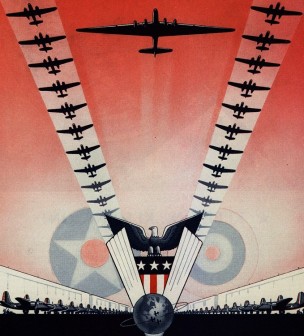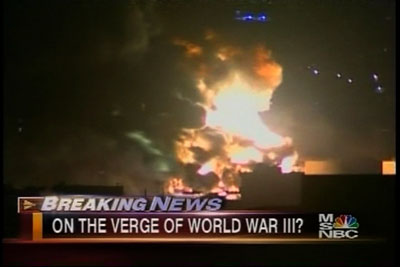
by Mahdi Darius Nazemroaya
December 11, 2010
from
GlobalResearch Website
|
Mahdi Darius Nazemroaya is a
Research Associate at the Centre for Research on Globalization (CRG). |
The tragic attacks of
September 11, 2001 have
resulted in almost ten years of perpetual war.
September 11, 2001 was the first drum beats, or
the opening salvos, of a much wider conflict. The deployment of U.S. and
NATO troops in Afghanistan has secured a bridgehead into the Eurasian
Heartland, which is geographically positioned on or near the borders of
Iran, China, India, Pakistan, Russia, and the former Soviet republics of
Central Asia.
Was Afghanistan the starting battle of a global war?

The invasion of
Afghanistan can be compared to the landing of the Western Allies,
specifically the Americans, in North Africa as a bridgehead into Italy and
Europe.
At the same time
NATO has been pushing from
Europe towards the Eurasian Heartland, like the landing of the invading
forces of the Western Allies in France.
Was September 11th,
2001...
The start of the Third World War?
Historically speaking, it should be noted that distinctions between times of
war and peace are not always clear-cut and conflicts do not always
correspond to the dates set and standardized by historians.
War was not even declared in the cases of many
past conflicts, such as in the early 1700s when Augustus II of Saxony-Poland
invaded Livonia or when Frederick IV of Denmark invaded Holstein-Gottorp.
Also, in the cases of many conflicts, attempts were always made to cloak or
hide the nature of the conflict as being a war or an act of aggression.
The Romans and other imperial powers regularly
engaged in this type of conduct.
Examples in history are the abstract chronological dates customarily used by
historians to note important points in the Second World War and the start of
the Cold War.
-
In Western Europe and North America, the starting date for
World War II is considered to be September 1, 1939, when Germany invaded
Poland.
-
For the former Czechoslovakia, March 16, 1939 (the date Germany
invaded Czechoslovakia) was the starting date for the Second World War.
-
In Russia and the former U.S.S.R. the start date
of the Second World War is 1941, the date the Germans invaded the Soviet
Union.
-
Even the end date for World War II in Europe is different, because
Germany officially surrendered to the Western Allies (namely the U.S.,
Britain, and France) on May 8, 1945 and to the Soviet Union on May 9, 1945.
The above dates are all set from an ethnocentric European perspective, which
leaves out Asia.
The history of World War II starts much earlier in Asia.
Many consider the start of the Second World War to have been when Japan
invaded China in the Second Sino-Japanese War in 1937, two years before
1939. Even before 1937, since 1931 the Chinese and
Japanese were in conflict and 1931 too can be seen as the start of World War
II.
The various dates and events for the start of the Cold War also vary,
because of the identification of various events as the Cold War’s opening
salvo(s).
-
the 1945 American-Soviet tensions over the occupation of the
Korean Peninsula
-
the Azerbaijan Crisis (1947-1948) arising from the Soviet
occupation of Iranian provinces
-
the near wins for the Communists in
national elections held in France and Italy (1947-1948)
-
the struggle for
power between the Communists and the non-Communists in Czechoslovakia
(1947-1948)
-
the West Berlin Blockade (1948-1949) are also viewed as
starting dates for the Cold War
Even events taking place during the Second
World War, such as the Yalta Conference, the Tehran Conference, and the
dropping of the atom bomb on the Japanese in Hiroshima and Nagasaki by
President Harry Truman as a threat to the Soviets (about U.S. supremacy in
the post-war order) are considered as the starting dates of the Cold War.
This question about dates also gives rise to another point in
historiography.
The nature of history is seamless and not the arbitrary one
unintentionally made out by historians and history textbooks. One set of
events leads to another. Just as how the First World War led to the Second
World War and the Second World War led to the Cold War, the Cold War has led
to the “Global War on Terrorism.”
The point is that in retrospect, historical dates and events are defined by
people in the future and that sometimes people need to stand back to see the
bigger picture.
The NATO and Anglo-American invasions of Afghanistan and Iraq are clearly
tied to September 11, 2001. These events are also related to the military
threats directed against Iran and Syria, the tensions in Lebanon and East
Africa, as well as U.S. and NATO threats directed against China and Russia.
In this regard, the historians of the future may say that World War III
could have started on September 11, 2001 or that the tragic events on
September 11, 2001 were a prelude to World War III.
Revelations from the U.S. Media on the Dawn of the 2006 Israel-Lebanon War
Are We in a World War?
As a note on the subject of whether World War III is currently being waged,
the U.S. media watchdog Media Matters for America made a note that much of
the mainstream media was touting that the U.S. was in the midst of a global
war days after Israel began its war against Lebanon.
Media Matters for
America reported as follows on July 14, 2006:
Most recently, on the July 13 [2006] edition of
Fox News’ The O’Reilly
Factor, host Bill O’Reilly said,
“World War III... I think we’re in it.”
Similarly, on the July 13 [2006] edition of MSNBC’s Tucker, a graphic read:
“On the verge of World War III?”
As Media Matters for America has noted, CNN
Headline News host Glenn Beck began his program on July 12 [2006] with a
discussion with former CIA officer Robert Baer by saying,
“we’ve got World
War III to fight,” while also warning of the “impeding apocalypse.”
Beck and
[former] officer Robert Baer had a similar discussion on July 13 [2006], in
which Beck said:
“I absolutely know that we need to prepare ourselves for
World War III. It is here.” [1]
The
mainstream media serves as a tool for the economic and political elite.
It falls into line in propagating and supporting state domestic and foreign
policy. In this sense the mainstream media is a vital component of a
military-industrial-financial-media complex that helps shape the views of
what the sociologist C. Wright Mills has termed a mass society.
It is clear that a World War III scenario was possible in 2006. The Israeli
attack on Lebanon could have expanded into Syria. This would have seen
Iranian intervention, which would have seen the U.S. and NATO entering the
war to come to the aid of Tel Aviv as combatants. This could have resulted
in a dangerous global war scenario arising from the Middle East, which will
be examined later.
The dangers of a military intervention by the U.S. and NATO were very real.
The Pentagon had planned to launch a NATO invasion of Lebanon, which would
have included the deployment of U.S. Marines to fight the Lebanese
Resistance.
This has also been confirmed by Alain Pellegrini, the former
military commander of the United Nations Interim Force in Lebanon (UNIFIL),
in an interview with the newspaper As-Safir.

The Valleys and
Mountains of Afghanistan
Just the Beginning of the “Long War”
The Weekly Standard, in the following month after September 11, 2001,
ominously went on to outline the broader military campaign that was to come
in an editorial by Robert Kagan and William Kristol published on October 29,
2001:
When all is said and done the conflict in Afghanistan will be to the war on
terrorism what the North Africa campaign was to World War II: an essential
beginning on the path to victory. But to what looms over the horizon - a
wide-range war in locales from Central Asia to the Middle East and,
unfortunately, back again to the United States - Afghanistan will prove but
an opening battle. [2]
The Weekly Standard editorial, like a script, went on to clearly state that
the multi-front war that was in the works would develop to become or
resemble the “Clash of Civilizations” post-Cold War conflict model outlined
by Samuel P. Huntington:
[T]his war will not end in Afghanistan. It is going to spread and engulf a
number of countries in conflicts of varying intensity. It could well require
the use of American military power in multiple places simultaneously. It is
going to resemble the clash of civilizations that everyone has hoped to
avoid. And it is going to put enormous and perhaps unbearable strain on
parts of an international coalition that basks in contented consensus. [3]
In 2001, both Robert Kagan and William Kristol were well aware of the
conflagration of war in Eurasia. Both men are U.S. political insiders that
were aware of what direction U.S. foreign policy would take the U.S.
military.
After all Kagan and Kristol were associates with
Dick Cheney,
Donald Rumsfeld, and Paul Wolfowitz through the political think-tank the
Project for a News American Century (PNAC) that outlined a global military
roadmap for a “new American century.”
World War III in the Horizon?
Since the invasion of Taliban-controlled Afghanistan war has spread from
Central Asia to the Middle East, Pakistan, the Caucasus, and East Africa.
The “Great Game” for control of all Eurasia, from Eastern Europe and the
Middle East to Central Asia, is underway. International tensions are
building. In Eurasia and worldwide there is geo-political rivalry between a
U.S. led military alliance and bloc and a Russian-Chinese-Iranian
counter-alliance.
There are numerous fronts that can ignite a global war, but the Middle East
has the highest risk. If Israeli attacks in 2006 threatened to lead to a
global war, what would an attack on Iran lead to?
An Israeli-U.S. attack
against Iran and its allies could develop rapidly into a global war with the
use of nuclear weapons.
NOTES
[1] “Right-wing media divided: Is U.S. now
in World War III, IV, or V?”, Media Maters for America, July 14, 2006:
http://mediamatters.org/research/200607140017
[2] Robert Kagan and William Kristol, “The Gathering Storm”, The Weekly
Standard, October 29, 2001, p.13.
[3] Ibid.


